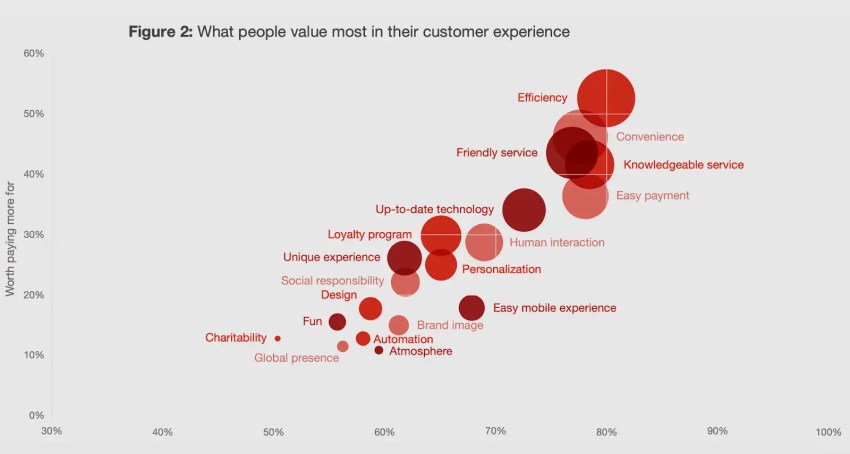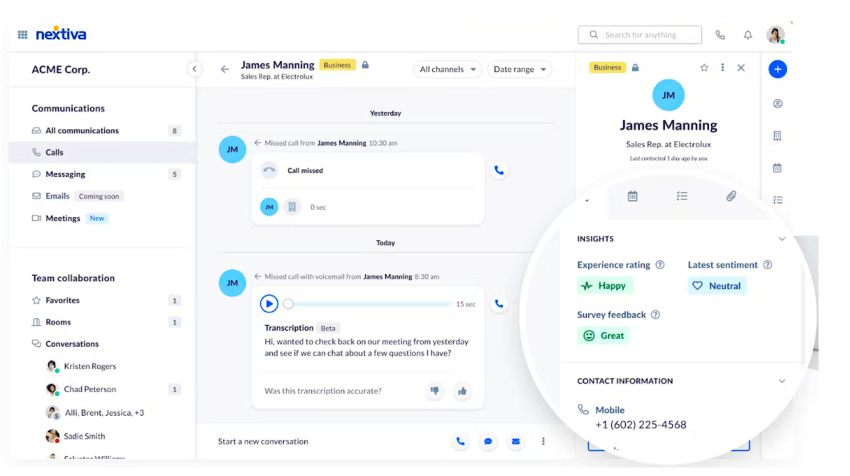Good customer service isn’t the product of a single department. It represents your entire company, and it’s the primary reason why customers stay loyal instead of switching to a competitor.
Even leadership is starting to recognize its impact on profit margins. The Nextiva CX Trends report shows 67% of companies saying their C-level executives now have a clear understanding of how customer experience contributes to business outcomes.
Key Customer Service Statistics for 2026: What the Numbers Show
Customer experience (CX) is becoming a core business priority rather than merely a support function. Most companies say they value CX because they can directly see its revenue impact, and many now recognize that it requires shared responsibility across teams.
Customers, meanwhile, expect a balanced mix of AI and human support — at least for now. This means bringing conversations, channels, and teams together so you can deliver personalized CX experiences.
- 47% of companies say their positive view of CX comes from being able to clearly track the revenue impact of their CX investments. (Nextiva)
- 66% of businesses said they planned to invest more in CX technology in recent years. But that’s not all. 84% of businesses using AI in CX say they plan to invest more. (Verint)
- 85% say their organization needs more shared responsibility for the customer experience, with 73% now including back-office teams in their CX technology decisions. (Nextiva)
- 89% of respondents also say positive customer service interactions require a balance between automation, AI, and the human touch. (Nextiva)
- However, when you look at the future, 24% of customers expect AI to match human capabilities in the next five years, and 25% expect that to happen in the next 10 years. (Salesforce)
- 40% of customers say AI raises the bar for the overall level of customer experience. (Salesforce)
- 26% are even ready to share personal info with AI agents if they believe it could better anticipate their needs. (Salesforce)
- 45% of businesses, on the other hand, say they’ve only made minor investments in AI. 36% find employee resistance to be a main reason for this. (Nextiva)
The State of Customer Service & Sky-High Expectations
The modern customer is more informed, less patient, and far more demanding than even a few years ago. Customers now want fast replies (often under five minutes), personalized interactions, and omnichannel customer support. But most importantly, they want conversations that feel human.
- 78% of customer service reps agree that customer expectations are higher than they’ve ever been. (HubSpot)
- 54% of consumers say fast responses are a must when choosing a brand, and 55% say they’ll stop doing business with a company if wait times are too long on any channel. (Freshworks)
- Yet, on the other end, 86% of agents say they’ve used tech that’s too slow to keep up with customer expectations. (Freshworks)
- Similarly, 74% of CRM leaders say constant tool-switching slows down ticket resolution and hurts overall efficiency. (HubSpot)
- 74% of U.S. customers reported having a bad service experience in 2022 — an 8% increase over 2021. (WSJ)
- Overall satisfaction has taken a slight hit, with the American Customer Satisfaction Index dipping to 76.9 in late 2025. (ACSI)
- Younger adults report the highest satisfaction (73%), and satisfaction drops with age. This could either mean older consumers have higher expectations or are more frustrated with modern CX approaches. (YouGov)
- Beyond just service, customers are more skeptical in general. They lost over $10 billion to fraud in 2023, making them more wary of unsolicited messages from businesses. (FTC)
- A key expectation is personalization, with 73% of customers expecting brands to provide personalized experiences as technology advances. (Salesforce)
- At the same time, only 47% of business leaders say their customer service experiences are highly personalized. (HubSpot)
- The technology is shifting, too. 75% of service leaders said they plan to move to a cloud contact center to better meet customer needs. (Deloitte)
- Reflecting this strategic shift, 79% of companies now see customer experience (CX) as a source of revenue, not just a cost. (Nextiva)
- On that note, 67% of CX leaders say it’s a lot easier to get approval for CX investments today. (Nextiva)

The ROI of Great Customer Service: How the Numbers Stack Up
Good customer service brings more than satisfied customers. It directly drives growth. Customers who feel valued remain loyal to you, even when you make mistakes.
And if you want to track ROI, you can track metrics like Customer Satisfaction Score (CSAT), Net Promoter Score (NPS), Customer Effort Score (CES), and First Contact Resolution (FCR), or use platforms like Nextiva that come with built-in analytics. They automatically show you exactly how faster responses, fewer transfers, and better conversations translate into higher retention, more revenue, and happier customers.
- 79% of companies are now saying their leadership views customer experience as a revenue driver, not a cost center. (Nextiva)
- The top metrics that business leaders track for CX are CSAT (31%), retention (31%), and response time (29%). (HubSpot)
- 88% of customers are more likely to make another purchase after a great service experience. (Salesforce)
- Similarly, consumers are 2.9× more likely to trust a brand after a 5-star experience compared to a 1- or 2-star one. (Qualtrics)
- That loyalty is based on understanding. 63% of customers expect service agents to know their unique needs and expectations before a conversation even starts. (Salesforce)
- A core part of that experience is empathy, which 68% of customers now expect brands to demonstrate in every interaction. (Salesforce)
- This positive feeling translates directly into advocacy. After a great service experience, customers are 5.1 times more likely to recommend your brand. (Qualtrics)
- In fact, 85% of customers say they’d buy from a company again after a good experience, and 66% would recommend it to friends and family. (Verint)
- The main factors in a review for consumers are: 1. Star rating; 2. Legitimacy; 3. Recency; 4. Sentiment; and 5. Quantity. (BrightLocal)
- Don’t be afraid to ask for reviews. 60% of customers have posted a business review when prompted by a brand in the last year. (BrightLocal)
- Engaging with feedback pays off, as 9 in 10 U.S. consumers say they are more likely to use a business that responds to all their online reviews. (BrightLocal)

The High Cost of Poor Customer Service
The flip side, however, is that while good customer service strengthens your brand, a single bad interaction can cause serious damage. The cost is not only a lost sale, but also a damaged reputation that can take years to repair.
Through digital channels like social media and instant reviews, the voice of a dissatisfied customer can reach thousands, and the financial consequences are devastating.
- Globally, businesses lose an estimated $3.7 trillion annually due to poor customer experiences. (Qualtrics)
- The three main reasons for poor customer service are having to repeatedly call a company (63%), not getting an immediate answer (43%), and not being able to contact a brand via the customer’s preferred channel (39%). (Verint)
- Bad CX takes a real toll on customers: 56% said it wasted their time (often 1–2 days), 43% lost money (about $1,261 on average), and 31% said it caused emotional stress. (CCMC)
- 13% of customers have also threatened legal action, and 8% have threatened to contact the media. (CCMC)
- This also means customer frustration is quite high, with 63% of people who had an issue saying they felt angry about the experience. (CCMC)
- The damage isn’t just theoretical, as 65% customers have walked away from a brand for good because of poor service experiences. (Khoros)
- Not just that, 70% also say they’d switch to a brand’s competitor after a poor customer service experience. (Verint)
- Customers are getting more aggressive as well. 43% said they raised their voice, up from 35% in 2015, and the share of people seeking revenge has tripled from 2020 to 2023. (CCMC)
- 32% of people shared their biggest complaint on social media in 2023 — more than twice as many as in 2020. (CCMC)
- Negative reviews have a huge impact. 38% of customers will ignore a business with fewer than four stars. (BrightLocal)
- Not just reviews — review summaries also matter. 18% of consumers say they make decisions just from reading the summary. (BrightLocal)
- Similarly, customers are more likely to buy from your brand if you reply to all reviews (89%) or at least just the negative ones (55%). (BrightLocal)
- But that’s easier said than done. About 21% of brands struggle to keep up with rising customer expectations, and 22% say they have a hard time even understanding what those expectations are. (HubSpot)

How Customers Want to Connect: Channels and Preferences
Customer service used to be simple: a phone number and maybe an email address. Today, customers want to reach you everywhere, including live chat, social media, and self-service portals.
Consumers expect a connected and omnichannel experience, no matter how they engage with you. This omnichannel world brings with it many challenges, as different demographics have increasingly higher expectations.
Phone and human support still matter
- Older adults overwhelmingly prefer the phone, with 50% of them naming it as their top channel. (YouGov)
- Businesses know this. Despite the focus on digital, 23% of businesses still planned to increase their spending on phone support. (Nextiva)
- 39% of customers say they prefer contacting companies via phone, and 66% had spoken to a brand on the phone in 2023. (Verint)
- In fact, the phone is also the primary complaint channel for most customers, at 50%. (CCMC)
Messaging apps and live chat lead the pack
- In 2024, 61% of customers said they prefer contacting brands via digital channels. It was 45% in 2023. (Verint)
- Not just that, 52% customers are more likely to stay loyal to companies that offer live chat, and 29% have told friends and family about positive live chat experiences. (Kayako)
- 79% of businesses also say implementing live chat has resulted in an improvement in sales and revenue, not to mention customer loyalty. (Kayako)
- And businesses are taking notice, as 40% of them plan to invest in live chat, 29% in SMS, and 27% in in-app messaging in 2025. (Nextiva)
Self-service and AI chatbots are closing gaps
- 52% of people say the biggest benefit to using self-service chatbots is that they save time and lead to faster resolution times. (Verint)
- Brands are also doubling down, with 57% already adopting or planning to adopt chatbots and voice bots in 2025 and beyond. (Nextiva)
- But this is not without its challenges — 68% of customers have had a bad chatbot experience in the past. Top reasons included chatbots not being able to answer questions or understand what a customer needed. (Verint)
Social media support is now customer-facing PR
- 21% of customers have spoken about a poor customer support experience on social media. (Qualtrics)
- In 2023, customers posted about their product or service experiences on social media an average of 41 times a year. They also viewed other people’s reviews, posts, and ratings an average of 69 times a year. This is almost double the numbers from 2020. (CCMC)
- Here’s how consumers use social media to find business reviews (BrightLocal):
- Youtube: 34%
- Instagram: 31%
- TikTok: 20%
- Reddit: 20%
- X: 13%
- Threads: 7%
- This also means more than half (56%) of businesses plan to invest in social media for customer engagement in 2025 and beyond. (Nextiva)
Omnichannel support is the new standard
- The modern customer journey is complex. People now use an average of nine different channels to engage with a single company. (Salesforce)
- 95% of companies have invested in multiple tools for CX. 13% of them use 10+ tools. (Nextiva)
- However, 81% of brands say the customer experience would be a lot better if they could consolidate all conversations into one system of record, or omnichannel platform. (Nextiva)
- 25% of brands have also implemented an omnichannel routing engine. 4 in 5 brands have also implemented channel steering strategies, with 36% of them having successfully deflected calls to other channels. (Deloitte)
Social Media & Customer Service
Social media is a public, high-risk customer service channel in which one viral complaint can cause more damage than a hundred phone calls.
Customers expect brands to be present, responsive, and effective on social media platforms, where every interaction becomes a public performance. The risks are high, but so are the rewards for brands doing it right.
- A massive 70% of customers report having used social media for customer service purposes at least once. (Sprout Social)
- And with Bluesky growing in popularity, the majority of users want brands to use the decentralized social platform for customer service and support. (Sprout Social)
- When customers contact a brand on social media, 76% expect a response within 24 hours. (Sprout Social Index)
- However, the unofficial gold standard is much faster. Between 39% and 43% of customers define a “good” response time on social media as being under three hours. (NapoleonCat)
- Despite this, the average brand response time on social media platforms is still around five hours. (NapoleonCat)
- The stakes are high for reviews. 93% of customers say online reviews influence their purchasing decisions. (Yelp)
- Video is also emerging as a service channel. 1 in 3 Gen Z consumers have used TikTok to learn about or purchase a product, and they often use the comments section to ask service-related questions. (Adweek)
- The cost of a social media interaction can be significantly lower than a call center interaction — sometimes as low as $1 per interaction compared to over $6 for a voice call. (Qualtrics)
- 76% of customers notice when companies prioritize customer support, and 51% specifically appreciate it when a brand responds to inquiries on social media. (Sprout Social)

The Rise of AI & Automation in Support
Today, AI is the biggest driver of automated customer service. It promises efficiency, instant responses, and personalized experiences on a scale humans could never achieve. But AI isn’t a cure-all.
If poorly implemented, it leads to customer frustration. The smartest companies aren’t using AI to replace their employees, but to support and empower them.
- The strategic importance is clear: 84% of business leaders believe automation is now an essential part of any successful customer experience strategy. (Verint)
- By the end of 2025, over 80% of businesses will have implemented some form of chatbot automation for customer interactions. (Gartner)
- In fact, 1 in 6 contact centers have already deployed generative AI capabilities in their call centers. (Deloitte)
- 69% of CX leaders also say their company has a plan to “ethically deploy” AI. (Genesys)
- The primary driver is speed, as fast response times are the single biggest influence on customer satisfaction (CSAT) scores. (Freshworks)
- Other benefits of generative AI in CX include improved customer effort scores (57%), higher agent productivity (56%), and more deflection to self-service (47%). (Deloitte)
- 76% of brands are using AI to personalize customer experience while 72% are using it to understand pain points in the customer journey. (Genesys)
- The goal is AI-driven personalization at scale. Netflix’s recommendation engine, which influences 80% of content watched, is a prime example of AI delivering a personalized experience that would be impossible for humans alone. (Invoca)
- But it’s not all good news. Frustration with bots is so common that 3 in 5 customers admit to having had a bad experience with customer service chatbots. (Verint)
- This is where the “hybrid model” comes in. The most effective use of AI is to assist human agents. AI-powered tools that suggest real-time answers for agents can reduce issue resolution time by up to 30%. (AWS)
- This is also why 51% of brands prefer “autopilot” tools that allow humans to oversee AI interactions, and 44% are choosing agent-assist tools. (Nextiva)
- Nearly half of employees expressed a desire for more formal training and believe it’s the best way to encourage AI adoption. However, more than a fifth reported receiving minimal or no support. (McKinsey)
- Looking ahead, 57% of service professionals believe automated voice assistants will become a top channel for customer communication. (Salesforce)
- But chatbots are only one part of the picture. CX teams are using AI for other purposes like customer journey management (23%), sentiment analysis (22%), agent coaching (22%), and even empathy analysis (20%). (Genesys)
- 72% also believe AI will initiate proactive customer service in the future. (Genesys)
- Still, the return on investment can be a journey. Only 26% of companies in the early stages of AI adoption report seeing “high value” from their efforts, highlighting the importance of a clear strategy. (Nextiva)

Generative AI and real-time personalization
One aspect that customer service reps are really doubling down on with AI is real-time personalization. Instead of using generic replies or rigid scripts, reps are leaning on generative AI to predict intent, tailor responses, and adjust messaging based on customer feedback analysis, sentiment, and context.
According to Nextiva’s 2025 CX Trends report:
- 39% of companies already use generative AI to write to customers, (and another 25% plan to in the future).
- 25% are using AI-driven personalization today (and 25% more plan to adopt it).
- 24% are also using real-time sentiment analysis to better respond to customer needs.
When automation fails: balancing tech with the human touch
Customer service automation can speed things up, but it can’t replace humans — especially when issues get emotional, complex, or high-stakes. In Nextiva’s 2025 CX Trends Report, 98% of leaders say smooth AI-to-human transitions are essential, yet 90% admit they struggle to make those handoffs work.
A big reason: disconnected systems and messy data. When AI tools don’t have access to accurate, up-to-date customer information, they give inconsistent answers, fail to recognize intent, or make customers repeat details they already shared. This is also why 51% of the companies we surveyed are choosing “autopilot” models to handle the busywork while still keeping a human in the loop to monitor, correct, and step in when needed. This hybrid approach acknowledges the limits of AI while preserving the speed customers expect.
The Human Side: Empowering Support Teams for Better CX
Agent well-being is becoming just as important as customer satisfaction. Support teams are stretched thin, and companies are realizing that burnout leads directly to poor experiences. The future is as much AI-powered service as it is AI-supported employees.
Brands are investing heavily in upskilling and smarter tools so agents can feel supported and deliver consistently better customer care.
- 87% of call center workers report being highly stressed, and over half say they feel emotionally drained. (Freshworks)
- But, on the other hand, companies that invest in agent career growth hit 23% more of their strategic goals than those that only plan to. (Deloitte)
- This means hiring and retention are a top priority for most companies, and brands plan to invest 24%–39% of their budget here. (Nextiva)
- 33% of companies are planning to invest more in employee upskilling in 2025 and beyond. (Nextiva)
- In fact, 53% of brands have already made significant investments in training employees to use AI effectively. (Nextiva)
- Similarly, 44% of businesses rate AI agent support as a great way to help agents give the best possible support experience. (Nextiva)
Customer Service Trends & Predictions 2026
Customer service is changing at an ever-increasing pace. The coming years won’t be about a single technology, but rather how data, AI, and a more human-centric approach work together to create more proactive, empathetic, and integrated experiences. Here are the key trends shaping the future of customer support.
Proactive and predictive support powered by AI
The future of great service is solving problems before the customer knows there is one. Instead of waiting for a complaint, businesses are using AI and data to anticipate needs. Imagine a carrier automatically rerouting your delayed package and notifying you of a solution, or your streaming service reporting a billing error and fixing it before your card is charged.
Proactive customer service transforms support from a reactive function to a proactive value driver.

Immersive and visual support with AR
For complex or technical issues, text messages and phone calls are often insufficient. Augmented reality (AR) will become an important support tool, especially in the hardware, electronics, and assembly industries. A customer can point their phone’s camera at a product, and the support agent can “draw” instructions on the screen, circle the correct button, or display a 3D animation of the solution in real time, reducing resolution time and customer frustration.
The rise of emotionally-aware AI
The next challenge for AI is emotional intelligence. Future virtual agents will be able to recognize human emotions — such as frustration, urgency, or satisfaction — based on the tone or wording of a chat message. Customer sentiment analysis will allow bots to respond more empathetically, automatically adjust their approach, or — most importantly — identify the perfect moment to escalate a conversation to a human agent who can establish a genuine emotional connection.

The empowered “super agent” with AI copilots
As AI handles simple, repetitive requests, the human agent’s role will evolve. They will become “super agents” — highly skilled problem solvers who exclusively handle the most complex, sensitive, and high-value customer interactions.
AI-copilots and agent assists will provide agents with instant information and context to support them and allow them to focus on critical thinking and building customer relationships. This will make the agent’s work more rewarding and valuable than ever.
Unified customer data becomes non-negotiable
The omnichannel concept will be a centralized, unified customer data profile. The silos between marketing, sales, and customer support will finally be eliminated. Every employee will have a complete overview of the customer history — previous purchases, support tickets, marketing interactions, and personal preferences — in one place. Customers will no longer have to repeat themselves, and personalization will be effortless and intuitive.

Radical transparency and customer-led communities
Brands will build trust through radical transparency, meaning openly admitting mistakes, publishing how they respond to customer feedback, and actively building user communities on forums like Reddit. Instead of just a personal support ticket, customers can find answers from other experienced users in brand-sponsored forums and third-party review sites like G2, Gartner, Trustpilot, and Capterra.
This is why review and reputation management are becoming core responsibilities for CX teams. Modern customer service platforms like Nextiva now include built-in tools to manage reviews, respond faster, and pull that feedback directly into a unified inbox. That way, customer sentiment, issues, and public reputation all live in one place.

Gen AI-driven proactive outreach
AI is pushing CX beyond reactive support and into true anticipation. Instead of waiting for a ticket, brands are using predictive signals to spot problems early, reach out first, and — in some cases — resolve issues without the customer ever noticing.
According to a report by Genesys, 72% of CX leaders believe AI will eventually power all proactive outreach, and 59% expect it to directly increase customer loyalty and lifetime value.
This is because AI can detect behavior patterns, identify friction, predict needs, and trigger tailored outreach at the right moment and in the right channel.
Turn Conversations into Connections that Drive Loyalty
The takeaway from these customer service statistics is simple: every interaction is a chance to build (or lose) trust. As expectations rise, the brands that win are the ones that respond faster, personalize smarter, and most importantly, support their teams.
And if you’re ready to simplify that entire journey, Nextiva brings calls, messages, video, CRM, and AI-powered insights together in one platform. This means better agent productivity, better response metrics, and better customer satisfaction rates.
The customer experience platform customers love.
See how Nextiva’s unified customer experience platform helps you put these insights into action and build the loyal customer base your business deserves.

















 Customer Experience
Customer Experience 














